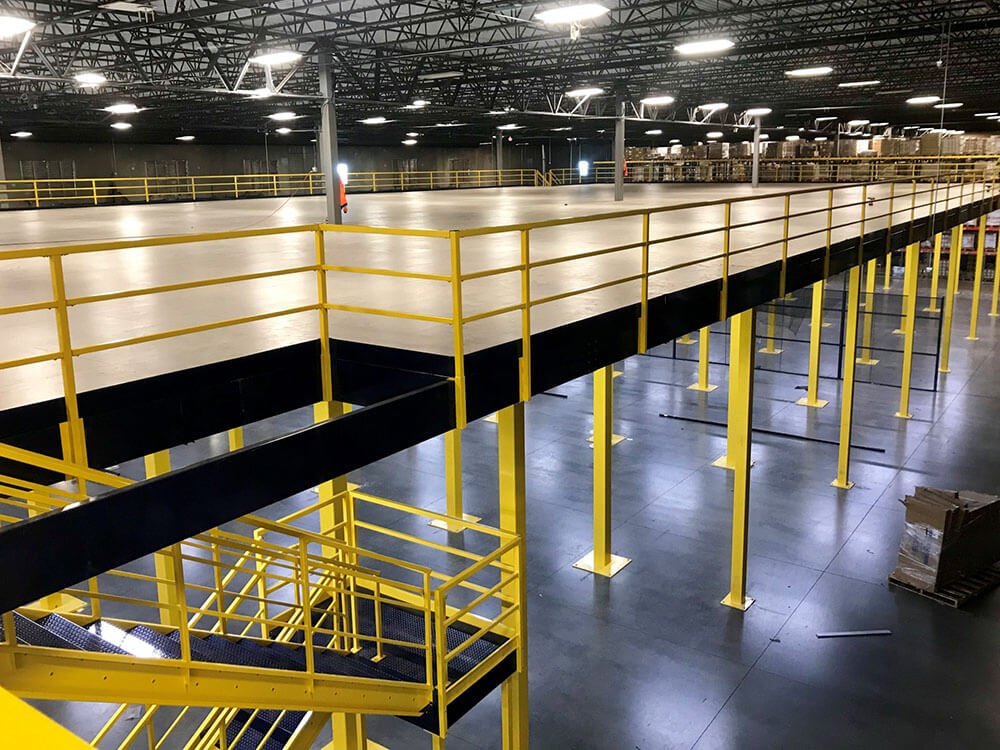Space is always a crucial concern when it comes to storing stuff. Do you know if you build a mezzanine, you can actually optimize your limited space very efficiently?
Have you ever thought of building a mezzanine floor in a warehouse or building a mezzanine floor in a house? If not, then go through this guide below, and by the end, you will be amazed to see how beneficial and efficient it could be. This mezzanine floor design guide has everything you need to know about building a mezzanine.
What is a Mezzanine Floor?
A mezzanine floor is a floor that is built between the two floors of a building without any extension on the footprint of the space. The mezzanine floor can make the best use of vertical space and create an additional storage area.
Mezzanines can either be permanent or temporary and are created using steel and wooden structures based on the design requirements. These mezzanine floors are very common in commercial sectors like retail stores. They help to create additional space for display and even in industrial environments for the warehouses.
Mezzanine floors are common in residential setups too and may offer home offices and extra space for living rooms. Mezzanine floors are not always to store your stuff but you can even make it an added space that can be used for any purpose.
Cheapest Way to Build a Mezzanine Floor
When you are planning to build a mezzanine floor the most important thought that may click in your mind is looking for the cheapest way to build a mezzanine floor. This section below features a detailed analysis of the aspects that may help you save in building a mezzanine floor.
Materials to Consider:
The major consideration in a mezzanine floor construction is material. There are different types of materials that can be chosen for building mezzanine floors and among them, wood, and steel are quite popular.
Wood is one of the cheapest materials and is also easy to work with, but the durability of wood is not as good as steel. Steel offers suitability to handle heavy loads and hence is long-lasting. For more information about mezzanine floor materials, please read our article mezzanine floor material.
DIY vs. Professional Installation:
Mezzanine floors can be built either as a DIY project or you can go for a professional installation. A DIY project is suitable when you have to make a small-scale mezzanine but you must have the required skills.
Whereas, professional installation requires incorporating professionals to get the job done perfectly and is suitable for a large-scale installation. However, professional installation also has high costs attached.
Cost-Saving Tips:
You can cut the cost of building the mezzanine floor in various ways and some of these cost-cutting tips are:
- Incorporate recycled materials, like used metal and wood.
- Optimize your design and keep it very simple, a simple design uses less material and incurs less labor expenses.
- Opt for budget-friendly materials like modular steel and reclaimed wood, it is cheaper.
Sourcing Affordable Materials:
When you are sourcing materials for the mezzanine look for affordable options where you can find cheaper material. You can consider online social marketplaces and even some stores supply second-hand building materials. Some construction companies even sell the leftover material at discounted rates. It helps to lower your cost when you source the material efficiently.
Simplifying the Design:
A simple design is always suitable for a limited budget, when you reduce the complexity of building a mezzanine the amount of material needed will also reduce. Try to eliminate the custom features and multiple levels, and keep it practical and affordable.
Modular Solutions:
Modular mezzanine systems are very easy to install and affordable. They are designed for later expansion and are extremely flexible compared to building a mezzanine from scratch.
Cost to Build a Mezzanine Floor
The cost to build a mezzanine floor is based on many factors and some of these are discussed here.
Factors Influencing the Cost:
The cost involved in building a mezzanine floor is dependent on many factors. This comprises the choice of material and size as well as the location where the mezzanine has to be built.
Materials are of different types which range from steel to wood where wood is a cheaper option compared to steel. Similarly, the size also impacts the amount of material to be used and the expense of labor which adds up to the cost.
Moreover, if the location of the mezzanine is commercial, the requirement of expert labor is needed and for a small home mezzanine, the DIY project can be carried out.
Cost Breakdown:
The cost breakdown of a mezzanine floor varies based on the material chosen, size, and the space for which the mezzanine is required. However, roughly it is between $50 to $150 per square foot.
Comparing Costs:
The different mezzanines have different costs. The warehouse mezzanine is the most expensive one because the heavy-duty materials are required and the mezzanines are even larger in size. Whereas the residential mezzanines are less expensive based on the material used and stairs and railings are incorporated.
Mezzanine Floor Design Guide
The mezzanine floor design guide below will help you consider different design choices for the different mezzanines.
Design Considerations:
Designing a mezzanine floor costs by considering various factors like load-bearing capacity which is based on the usage. When required for warehouses the mezzanine must be heavy duty and when needed in-house the light load-bearing capacity would be chosen.
Similarly, the mezzanine floor height requirements also play a vital role as sufficient headroom is a must. The accessibility of the mezzanine comprising lifts, stairs, and ramps is also considerable. The mezzanine design must adhere to the safety precautions like rails and fire exits.
Different Design Options:
Every type of space would have a different design option and some of these are as follows:
- Warehouse mezzanines are made using heavy-duty steel which helps in holding heavy loads and also incorporates conveyor systems and racks.
- Garage mezzanines have simple designs and are made using steel and wood suitable for light equipment.
- Residential mezzanines are more on the aesthetic side and used for home offices or an added living space.
Planning Your Layout:
To plan the layout of the mezzanine efficiently, it is important to keep in mind the flow of movement. It is important to utilize the area at its maximum either as a workspace or storage.
A simple design is always the easiest in terms of navigation as well as maintenance and the access points must be planned strategically.
Build a Mezzanine Floor in the Warehouse
If you are looking to build a mezzanine floor in warehouse some of the aspects about it that are important to be understood are discussed in this section.
Benefits of Mezzanine Floors in Warehouses:
- Mezzanine floors in a warehouse offer enhanced storage capacity as you get an additional area for storing products.
- The organization of the warehouse products is well sorted.
- The need for increasing the footprint of the warehouse is eliminated and the limited space is well utilized in the limited height.
Design and Construction Tips:
The design and construction of a mezzanine floor in a warehouse comprises some important tips as given below.
- Warehouses need to handle heavy loads and the structure of the mezzanine must be capable of handling it. Hence, when choosing materials and planning the design ensure that it has relevant structural integrity.
- To avoid disruption during workflow, make sure to optimize the column placement in a better way.
- Incorporate flooring materials that are durable like wood and steel gratings.
- To make your warehouse equipped with efficient material handling try to create a conveyor system and pallet gates.
Compliance with Safety Standards:
Designing warehouse mezzanines also requires accounting for the safety of the workers as well as the products. Some of the aspects to consider and incorporate are as follows:
- Make sure that the regulations for the load bearing are adhered to while building the warehouse mezzanine.
- Install guardrails and fall protection for safety.
- Incorporate evacuation routes and fire-resistant mechanisms to improve fire safety.
- Conduct inspections for safety on a regular basis.
Building a Mezzanine Floor in the Garage
Building a mezzanine floor in garage may be quite helpful in various ways. Some of the reasons why it could be beneficial and what are the important tips for having it are discussed here.
Why Build a Mezzanine Floor in a Garage?:
Some of the reasons to build a mezzanine floor in a garage are as follows:
- It provides you with an additional space for storage without having the footprint of the garage expanded.
- You can incorporate an extra workplace within the same garage.
- It helps you to organize your equipment and tools in the garage.
Step-by-Step Guide:
When building a mezzanine in the garage some of the conditions are as follows:
- Measure the height of the garage and ensure that there is enough headroom above and below the mezzanine.
- Keep the design as simple as possible and try to make the structure sturdy so that it can handle the load.
- Choose flooring materials that are durable like metal decks or plywood.
- Incorporate easy access in the form of stairs.
Garage-Specific Tips:
To make the best mezzanine for a garage some garage-specific tips include:
- Make the most of vertical space by reducing the height of the garage.
- Do not overload the mezzanine and use it for light storage.
- Consider a modular design so that it can be installed easily and even take into consideration some future adjustments.
Building a Mezzanine Floor in a House
By building a mezzanine floor in a house you can have a small workspace or a cozy living room. Some essential aspects regarding building mezzanine floors in a house are highlighted in this section.
Residential Applications of Mezzanine Floors:
Residential mezzanine floors can be incorporated for various reasons and the three most important reasons are as follows:
- You can have an added space where you can have a small bedroom or a living room.
- If you need a storage space, you can utilize this mezzanine floor as a storage space.
- You can choose to design a home office in the mezzanine.
Design Considerations for Homes:
When building a mezzanine for a home you have to consider some design elements as follows:
- The colors and themes must match with your home decor to balance the aesthetics.
- Ensure that the mezzanine is airy and captures some sunlight.
- Consider incorporating stairs that are compatible with the style of your home.
Safety Precautions:
When building a mezzanine at home there are some safety precautions that must be a part of your design and these are as follows:
- The structure of the mezzanine floor should be stable enough to support the usage for which you are building it.
- Secure the edges of the mezzanine with railings and barriers.
- Incorporate guard rails and gates for the stairs if you have children at home.
How to Build a Mezzanine Floor for a Bedroom
If you want to learn how to build a mezzanine floor for bedroom you can find a lot of useful information in this section.
Transform Your Bedroom with a Mezzanine Floor:
- Utilize the vertical space in your bedroom and create your sleeping area in the mezzanine. It will provide you with ample space in the room which you can create as a mini lounge.
- If you have a small bedroom, you can utilize the limited space of your room without extending the footprint.
DIY vs. Professional Help:
- You can opt for a DIY mezzanine floor in your bedroom but you should know the basic skills of carpentry and also have the right tools.
- You can also seek professional help to have a mezzanine for your room. It will ensure safety and adherence to structural integrity but is costly.
Creative Bedroom Designs:
- You can enhance the design of the bedroom with a mezzanine by having a loft-style bed that has a desk or storage under it.
- By adding ladders and stylish stairs you can add a very appealing look to the room.
- Incorporate glass panels to enhance the light flow.
- Incorporate some creative lighting ideas which enhance the aesthetics of the mezzanine floor.
Common Challenges and How to Overcome Them
When you build a mezzanine there will be some challenges that you may come across, this section below features those challenges and ways to overcome them.
Structural Issues:
The structural issues can cause concerns over the stability and load-bearing capacity of the mezzanine. It is very important to analyze that the structure would not get weak when the mezzanine is installed.
Some of the ways you can address these structural issues are as follows:
- Try to get assistance from a professional to analyze the structure and load-bearing capacity of your space. It will help to ensure that the additional weight is suitable to be added or not.
- Choose heavy-duty steel which can enhance the durability of the mezzanine.
- Incorporate columns and beams if possible so that the weight of the mezzanine can be distributed evenly.
Space Limitations:
Some spaces are irregular and small which makes it difficult to install a mezzanine. Hence, if you come across issues like low ceiling or space issues you can consider the tips below.
- Customize the design of your mezzanine so that it can fit with the shape and space you have available. You can do this by adding supports so that you can utilize the space to its maximum.
- Try to go for modular mezzanine systems which are scalable so that you can adjust them when you have more space in the future.
Compliance with Building Codes:
Mezzanine floors should adhere to safety, accessibility, and fire regulations to ensure the safety of the spaces.
- Consult the local authorities of the building to understand the local standards of mezzanine installation.
- Incorporate fire safety systems and escape routes in the mezzanine.
- Incorporate handrails and stairs to enhance accessibility.
Maintenance and Care for Your Mezzanine Floor
The care and maintenance of your mezzanine is crucial after you have built it. Some of these tips for care and maintenance are as follows:
Regular Inspections:
Conduct regular inspections and look for signs of wear and tear that are associated with structural integrity, It helps you assess that no compromise is made on the structural integrity of the mezzanine floor. Issues like corrosion, damages, and loose connections should immediately be repaired.
Cleaning and Upkeep:
Keeping the mezzanine floor clean also helps keep it clean from clutter and improves its operational safety. Some of these tips are as follows:
- Vacuum the mezzanine daily and keep the mezzanine floor clean of dirt and debris.
- In case something spills, clean it up immediately.
- Try to protect the flooring by keeping heavy stuff away.
Safety Checks:
Keep an eye on the safety of the mezzanine floor by incorporating some safety measures:
- Make sure that the railings are properly installed and inspect them regularly for any loose connections.
- Keep a check on stairways for any signs of wear and tear.
- Check the fire safety measures now and then to ensure they are working properly.
- Incorporate enough light to improve the visibility on the mezzanine floor.
Conclusion
When building a mezzanine floor and you need professional assistance you can consider Lracking. We design custom mezzanine floors for commercial as well as residential spaces based on your requirements. We understand the significance of adhering to safety standards and hence incorporate strong and durable structures.




